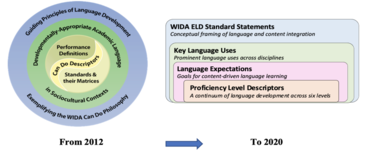The WIDA English Language Development (ELD) Standards Framework, 2020 Edition, offers a more clearly organized framework to represent content-driven language learning. Grade-level cluster resources include Language Expectations to create unit-level language goals for all multilingual learners as well as Proficiency Level Descriptors for measuring individual student language growth. Portions of this article contain excerpts from the WIDA English Language Development Standards Framework, 2020 Edition: Kindergarten-Grade 12 (WIDA, 2020), Wisconsin Board of Regents of the University of Wisconsin System, on behalf of WIDA.
Keywords: elementary, middle School, secondary, teacher education
The WIDA English Language Development (ELD) Standards Framework, 2020 Edition: Kindergarten-Grade 12 [2020 ELD Standards Framework] (WIDA, 2020) provides both content and language educators with a clearly-defined, user-friendly set of resources to support content-driven language learning. The updates to the 2020 ELD Standards Framework respond to federal legislative requirements (such as the Every Student Succeeds Act (ESSA) of 2015), evolving academic content standards, the latest developments in scholarly literature, and a deepened commitment to equity and social justice for multilingual learners and other minoritized students.
| Visit the WIDA ELD Standards Framework Webpage as well as your state education agency website for resources to support your local conversations and implementation plan. These resources include an introductory video, Q&A webinar recordings and transcripts, PowerPoint slides, FAQ series, and information on professional learning opportunities. |
This article provides a high-level comparison of the 20121 and 2020 ELD Standards Frameworks, targeting those educators who are already familiar with its 2012 precursor (WIDA, 2012). Figure 1 provides a comparison of the components in the 2012 and 2020 ELD Standards Frameworks.
In particular, this article unpacks the resources available within the grade-level cluster Language Expectations. Complementing this article, MinneTESOL Journal volume 37 issue 1 contains two companion articles: “Putting discourse first” (Lundgren & Shafer Willner, 2021), which examines how a focus beyond the word or sentence level can support the development of multilingual learners’ expressive language (speaking, writing, and representing) and “Making language visible in content area classrooms using the [2020] WIDA ELD Standards Framework” (Westerlund & Besser, 2021), which provides an overview of discipline-specific resources available to content area teachers.
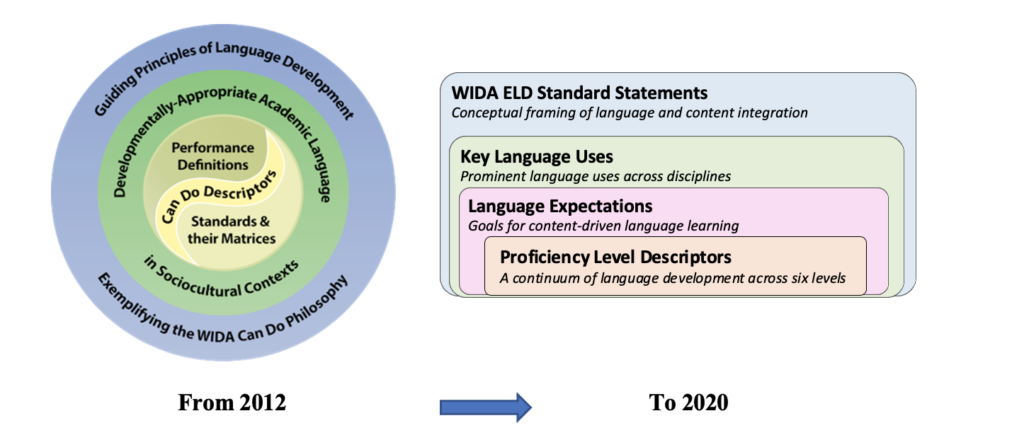
Core philosophies and big ideas maintained
Since its inception in 2003, WIDA has tailored its approach to standards to support and sustain students’ unique cultural and linguistic experiences, assets, interests, and potential (González et al., 2005; Paris, 2012). WIDA’s Can Do Philosophy (last updated in 2019; WIDA, 2019a) has served as the foundation for four editions of English Language Development Standards—released in 2004, 2007, 2012, and now 2020. This philosophy is also represented in the recently-updated Guiding Principles of Language Development (WIDA, 2019b).
Putting the Big Ideas into Action
For more information on the Big Ideas, see Section 1 in the 2020 Edition. |
In keeping with an assets-based philosophy, WIDA now refers to students identified as English learners (ELs) as multilingual learners. Multilingual learners are not “failed” native English speakers (Kibler & Valdés, 2016; May, 2014), but have a range of assets to call upon when engaging in learning, such as knowledge of multiple languages, varying representation of ideas, metalinguistic and metacognitive awareness, and varied life and educational experiences.
| Multilingual Learners
Language learners who regularly come into contact with and/or interact in languages in addition to English. Multilingual learners include English language learners, dual-language learners, newcomers, students with interrupted formal schooling, long-term English learners, English learners with disabilities, gifted and talented English learners, heritage language learners, student with English as an additional language, and students who speak varieties of English or indigenous languages Definition excerpted from 2020 ELD Standards Framework Glossary (p. 255) |
In addition to the foundational Can Do Philosophy and Guiding Principles, the 2020 ELD Standards Framework has four interwoven Big Ideas. Like the Can Do Philosophy, the Big Ideas support the design of standards-aligned educational experiences that are student-centered, culturally and linguistically sustaining, and responsive to multilingual learners’ strengths and needs. These Big Ideas offer strategic foci for addressing systemic challenges in the current educational landscape:
- Equity of access and opportunity is essential for multilingual learners’ preparation for college, career, and civic participation.
- Integration of language and content is critical in the planning and delivery of instruction.
- Collaboration among stakeholders is a shared responsibility for educating multilingual learners.
- A functional approach to language development prioritizes the purposeful use of language.
The Big Ideas anchor and are interwoven throughout the components of the 2020 ELD Standards Framework.
2020 ELD Standards Framework: Clarified and streamlined
The abstract nature of the five WIDA Standards Statements (see Figure 2) has at times led to confusion as to what WIDA means by standards. In a needs assessment conducted prior to the initiation of development work, educators requested a more streamlined set of standards with clearly-defined purposes (Kray, 2020; Shafer Willner & Castro, 2017).
The 2020 Edition clarifies that the WIDA Standards Statements [italics added for emphasis] are the first of four, equally important components that comprise the 2020 ELD Standards Framework [italics added for emphasis]. Working together, these four nested components provide a comprehensive picture of language development within and across academic content areas. A primary purpose of the 2020 ELD Standards Framework is to make visible the language that students need to engage in the disciplines, in particular, language arts, mathematics, science, and social studies. In turn, educators can plan together to simultaneously develop content and language in systematic ways. In the sections that follow, we explore each of the four components of the updated 2020 ELD Standards Framework.
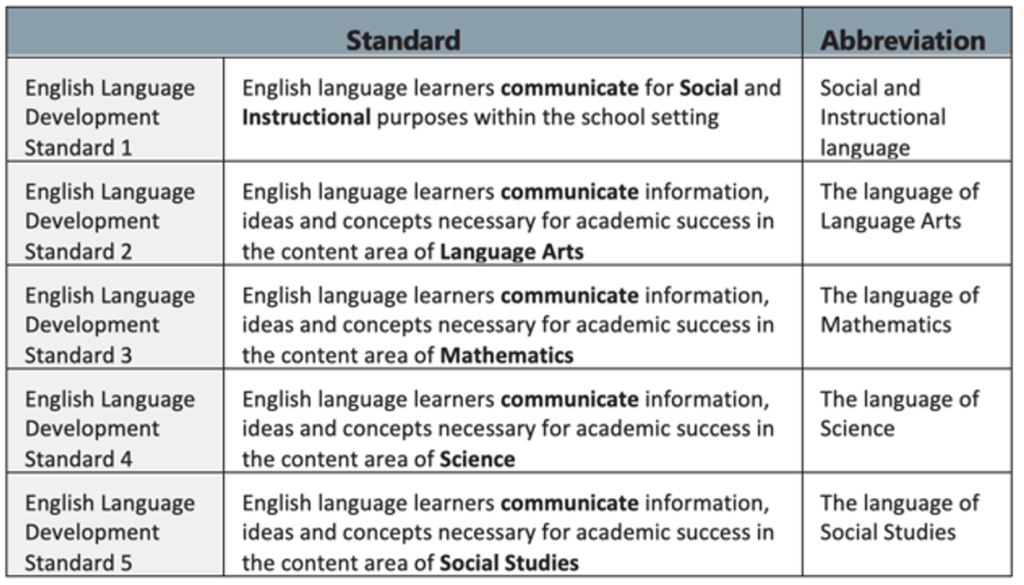
WIDA standard statements: Emphasizing language for thinking
Historically, WIDA has been intentional in presenting its ELD standards not as “junior English Language Arts (ELA)” standards, but as standards that address the language of both sociocultural and disciplinary contexts of schooling. Therefore, the five standards statements have always been positioned in relation to social and instructional language as well as disciplinary language. In comparison, other ELD standards in the U.S. have been framed as a subset of ELA standards (Shafer Willner et al., 2021).
To hone their focus, the five standards statements now employ new abbreviations, moving beyond the language of a content area (as if it were a finite, external, or static) to emphasize the use of language for thinking and acting in the world (Grant, 2012; Leont’ev, 1978; Vygotsky, 1978). The updated abbreviations of the standards statements are:
- Language for Social and Instructional purposes (ELD-SI)
- Language for Language Arts (ELD-LA)
- Language for Mathematics (ELD-MA)
- Language for Science (ELD-Sc)
- Language for Social Studies (ELD-SS)
Teaching Language for Learning
For more information about the Big Ideas, see Section 1 in the 2020 Edition. |
WIDA Standard 1: Expanding what we mean by academic language development
The 2012 Edition envisioned WIDA Standard 1 as working in conjunction with Standards 2-5. However, some educators interpreted Social and Instructional Language as functioning as a precursor to academic language or as used primarily by young children, newcomers, and students with limited or interrupted formal education (SLIFE) (Shafer Willner & Castro, 2017).
These misconceptions are rectified in the 2020 ELD Standards Framework. Here, everyday language is viewed as a legitimate contributor to academic language development (May, 2014) and as part of the continuum of choices students make in order to most effectively meet an activity’s purpose and other contextual variables (Derewianka & Jones, 2016; Halliday & Matthiessen, 2014). As a result, the 2020 ELD Standards Framework contributes to the movement to broaden the more traditional definition of academic language to include social language, approximations, and translanguaging (Canagarajah, 1999; García et al., 2017).
Enhancing Multilingual Learner Participation in Classroom Discussions
For more information on Standard 1, see Section 1 in the 2020 Edition. |
As in 2012, WIDA Standard 1 continues to connect the personal to the academic, conveying sociocultural influences on language: As students develop their identities as learners, their language use reflects their personal interests and needs, experiences, cultural and linguistic resources, social-emotional development, and family and community ways of knowing (Esteban-Guitart & Moll, 2014; Gándara, 2015). The positioning of Standard 1 in relation to Standards 2-5 is intentionally designed to send a message: The full range of students’ linguistic and cultural resources should be integrated with the language for making meaning in school (see Figure 3).
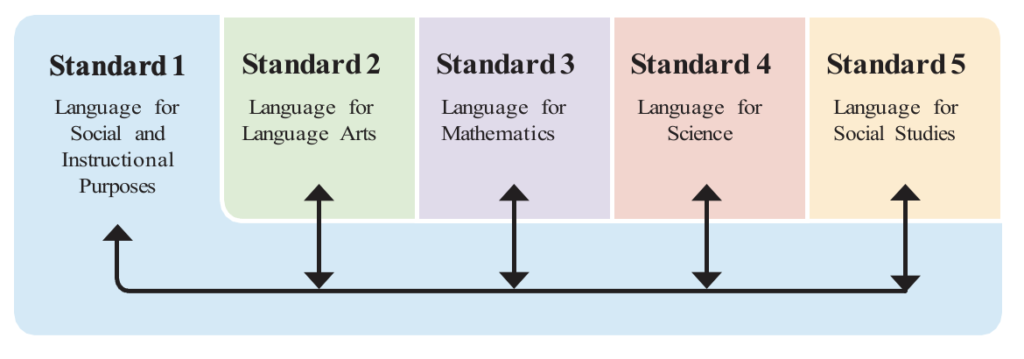
WIDA Key Language Uses: Making prominent the language uses in content standards
Key Language Uses, the second component nested within the 2020 ELD Standards Framework, offers an update to the Key Uses of Academic Language [Key Uses]: Recount, Explain, Argue, and Discuss (and described in Wright & Musser, 2014). To support educator and family interpretation of ACCESS for ELLs test scores, the Key Uses had been incorporated into the Can Do Descriptors, Key Uses Edition (WIDA, 2016).
For the 2020 ELD Standards Framework, the WIDA Standards Team conducted a review of current academic content standards for ELA/literacy, mathematics, science, and social studies, disciplinary practices, and related research literature (e.g., Brisk, 2014; de Oliveira et al., 2019).
When changing the name from Key Uses to Key Language Uses, the team connected with existing concepts of genre and purpose for language use (Hyland, 2007) and the notion of four broad genre families (Rose & Martin, 2012). The updated Key Language Uses represent those genre families prominently presented in all grade levels and content areas: Narrate, Inform, Explain, and Argue. They are defined in Table 1.
As commonly seen on a daily basis, the four Key Language Uses are not “boxes” for language to fit within, but can intersect, blend, and build on each other. For example, an argument may also contain narratives (anecdotes or stories), informational texts (which name, define, describe, compare or contrast something), and/or explanations (about the how or why of a concept).
The update from Key Uses to Key Language Uses represents a theoretical and linguistic refinement allowing greater clarity of terms. By splitting Recount into Narrate and Inform, there could be greater differentiation among the wide variety of genres within these two genre families. Since Discuss is not technically a genre family, it is no longer named a Key Language Use, but rather embedded within Standard 1 and still found across all Key Language Uses.
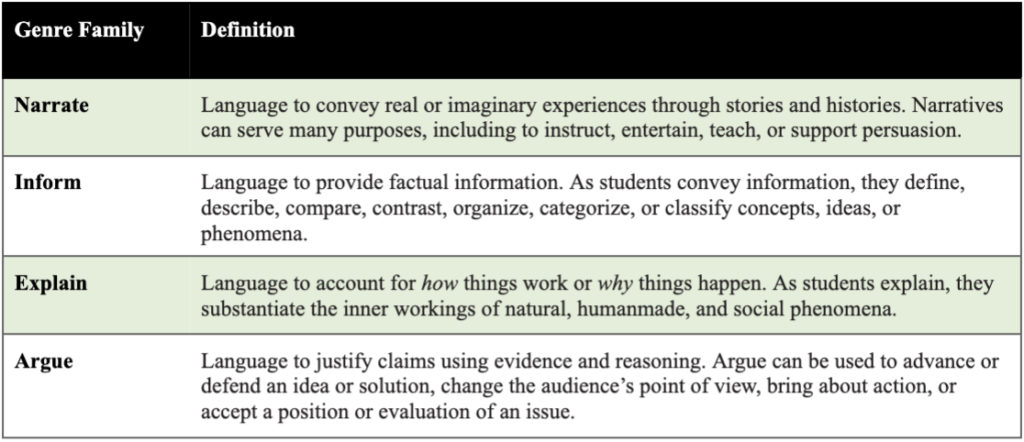
Table 1. Definitions of the 2020 Key Language Uses
Key Language Uses position multilingual learners not just as learners of language, but as language users who adapt their use of language in ways that are appropriate to context (Cook, 2003). Language users actively adapt language by topic, purpose, audience, and situation (Derewianka & Jones, 2016). This focus on the context for language use and the adaptability of language moves beyond a single, generic, one-size-fits-all Standard English and into an awareness of the dynamic varieties of English used by different communities (Pennycook, 2010). It opens spaces for students to have multiple and equally valid ways of using language to engage with the curriculum—ways that value who students are and what they bring to the classroom.
Making Prominent the Language Uses of Each Content Area
See the introduction to Key Language Uses in Section 2 of the standards book. For a deeper dive, check out “Key Language Uses: A Closer Look” in Section 4, or the “Theoretical Foundations” in Appendix F. |
Language expectations: making language for content driven learning visible
In the 2012 Edition, the Model Performance Indicators (MPIs) played a central role. They offered a generative process for creating task-level performance descriptions that, for each proficiency level, combined a language function, content stem, and support for an example topic or theme. (See Figure 4.)
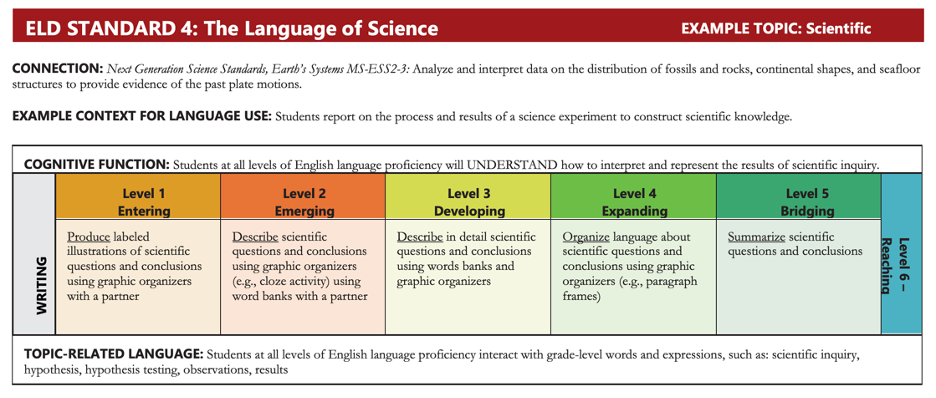
Even as the generative process for building MPIs was a step forward in creating examples of language differentiation for students, many educators still found this process to be too complicated and time-consuming (Kray, 2020; Shafer Willner & Castro, 2017). Lee (2018) also voiced concerns about MPIs, observing, “The Language Functions themselves imply varying degrees of cognitive demand, thereby altering the Cognitive Function of the task for students at different proficiency levels [especially for students at lower proficiency levels]” (p. 322).
Language Expectations, the third component of the 2020 ELD Standards Framework, focus on goals for content-driven language learning for multilingual learners at all levels of proficiency. While consistent with the focus of the MPIs, they offer a more stable, ready-made representation of content-driven language learning. Language Expectations are designed to be used in coordination with Proficiency Level Descriptors, which in turn, take into account the English proficiency levels of individual students.
Supporting conversations with content area educators, the Language Expectations have been written to be most similar to what educators generally find in academic content standards. As shown in Figure 5, they include reference codes that indicate the WIDA ELD Standard Statement, grade-level cluster, Key Language Use, and communication mode [ELD-SS.6-8.Explain.Expressive].
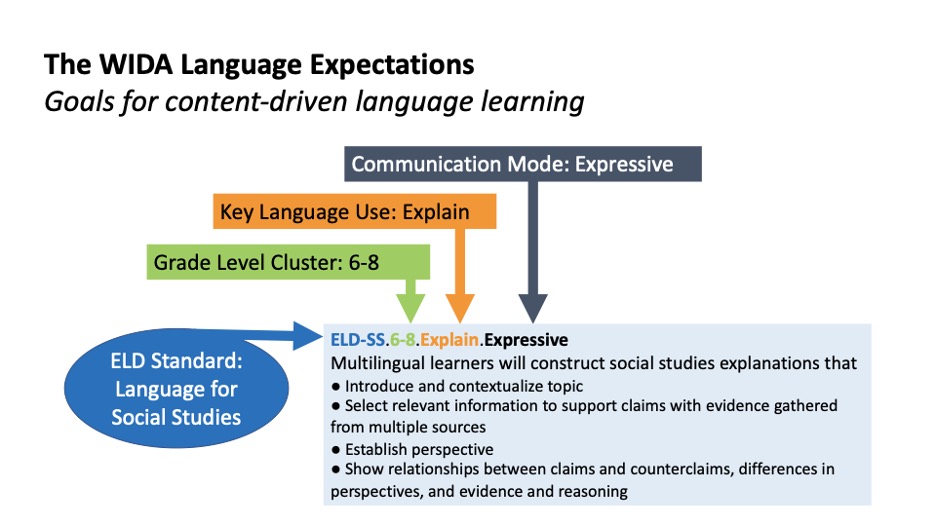
Language Expectations reflect the high-priority language students need for engaging in disciplinary learning. This is important since research has shown that explicitly teaching the language for learning the content has a strong, positive impact on multilingual learner academic performance in grade-level curriculum, instruction, and assessment (Aguirre-Muñoz & Ambiasca, 2010).
Integrating Language Expectations into Local Curriculum Maps
See the introduction to Language Expectations in Section 2 of the standards book. Language Expectations for each grade-level cluster appear in Section 3. Additional resources:
|
Highlighting similarities and differences among disciplinary literacies used by different content area communities
The 2020 Language Expectations have been written to convey both the broad similarities and the unique distinctions in how a Key Language Use might be interpreted or expressed according to its disciplinary context. For example, across disciplines, a bedrock of middle school argumentation is the triumvirate of claims-evidence-reasoning. Yet, social studies discussions of evidence emphasize use of multiple sources (Swan et al., 2013), while science discussions of evidence emphasize use of evidence, data, and/or a model about issues related to the natural and designed world(s) (Next Generation Science Standards Lead States, 2013). As shown in Table 2, Language Expectations are designed to convey the fundamental differences in “how knowledge is constructed, represented, and communicated” in each discipline (echoing the idea expressed in Goldman et al., 2016, p. 4).
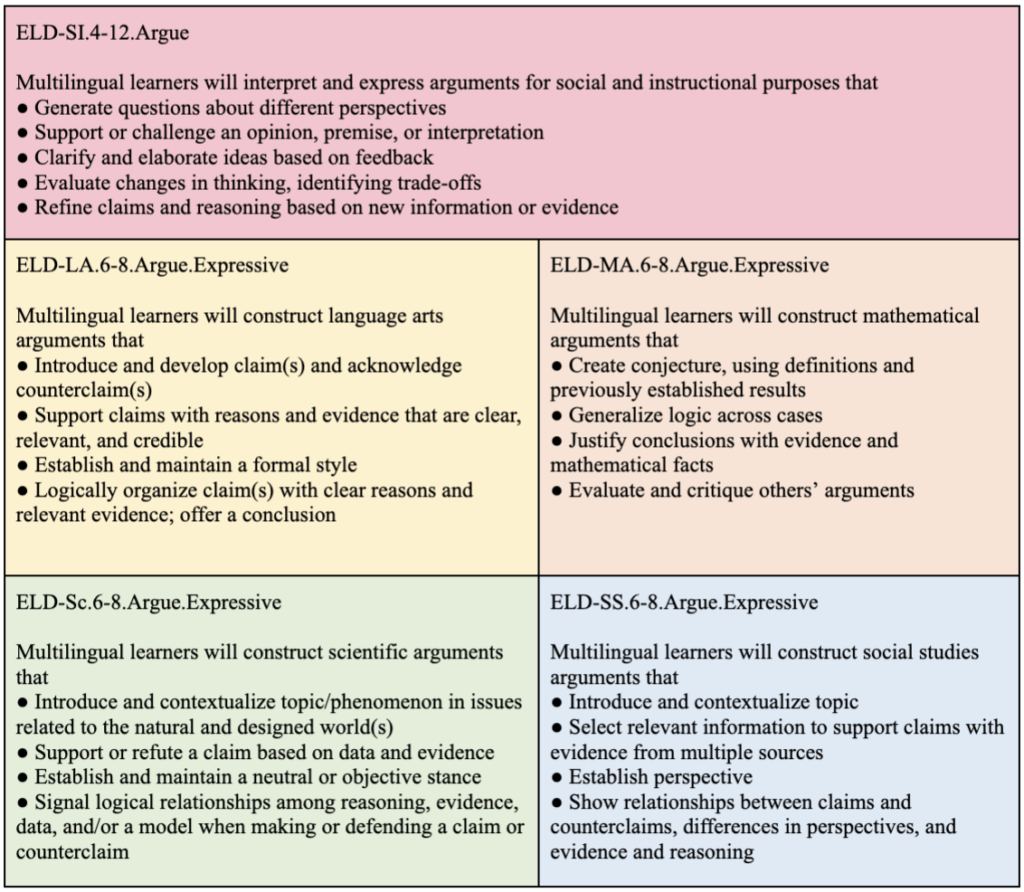
Table 2. Grades 6-8 Expressive Language Expectations for Argue for the Five Standards Statements2
Language Expectations can support systematic, explicit, and sustained language development in all program models (such as bilingual or sheltered immersion) and classroom settings, such as those driven by content learning (such as math or social studies), by language learning (such as English as a Second Language), or for integrated purposes. When collaborating with content area teachers, Language Expectations can be used to identify unit-level goals as destination points on a map. As teachers design varying and responsive scaffolding approaches, students may take different routes to reach these language destination points.
| Scaffolding Learning for Multilingual Learners
Multilingual learners’ language grows over time through real engagement with a challenging curriculum.
|
The resources found within the Language Expectations also use a nested design. Embedded within the Language Expectations are sets of Language Functions which describe what the students do with (and through) language to accomplish the purposes identified in the Key Language Use. However, in the 2020 ELD Standards Framework, the Language Functions unfold the Key Language Uses in commonly recurring configurations or stages (Martin, 2009). In other words, there is not one single Language Function per Key Language Use, but multiple Language Functions that might be used to work through and realize the most prominent Key Language Uses for each WIDA Standard Statement and grade-level cluster.
In the 2020 ELD Standards Framework, the grain size of a Language Function is broader than used with the previous MPI process. Here, the 2020 Language Functions are contextualized through a particular Key Language Use, grade-level cluster, and discipline. In other words, the 2020 Language Functions are broader than the initial “action verbs” (e.g., interpret, describe, evaluate, select, organize) often associated with Bloom’s Revised Taxonomy (Anderson & Krathwohl, 2001) since the information that comes after the initial language function verb can be just as important (e.g., character, concept, phenomenon, or evidence) in defining the genre. There are even instances where the same initial language function “verb” might be utilized in different Key Language Uses—e.g., compare or contrast concepts or entities in an informational text, compare and contrast objects or concepts, or compare reasoning and claims based on evidence from two arguments on the same topic.
At this point, educators who wish to dive deeper into explicit language instruction can use the associated Language Features. Consistent with the Big Idea of a Functional Approach to Language, language is defined as a resource for making meaning (italics added for emphasis) rather than as a set of rules for ordering isolated grammatical structures (Halliday & Matthiessen, 2014). Language offers a dynamic set of tools that can be used in the service of learning disciplinary concepts and practices (Schleppegrell, 2013).
Examples of Language Features (which help to carry out Expressive Language Functions) are shown in the clear sub-bullets in Table 3. In this table, the discipline (Science vs. Social Studies) informs the sampling of Language Functions and Language Features shown. (Please note that the Language Functions and Functions in Table 3 were extracted from Table 2.)
 Table 3. Grades 6-8 Science and Social Studies Examples of Language Features3
Table 3. Grades 6-8 Science and Social Studies Examples of Language Features3
Communication modes: Expanding accessibility for all multilingual learners through scaffolding and multimodality
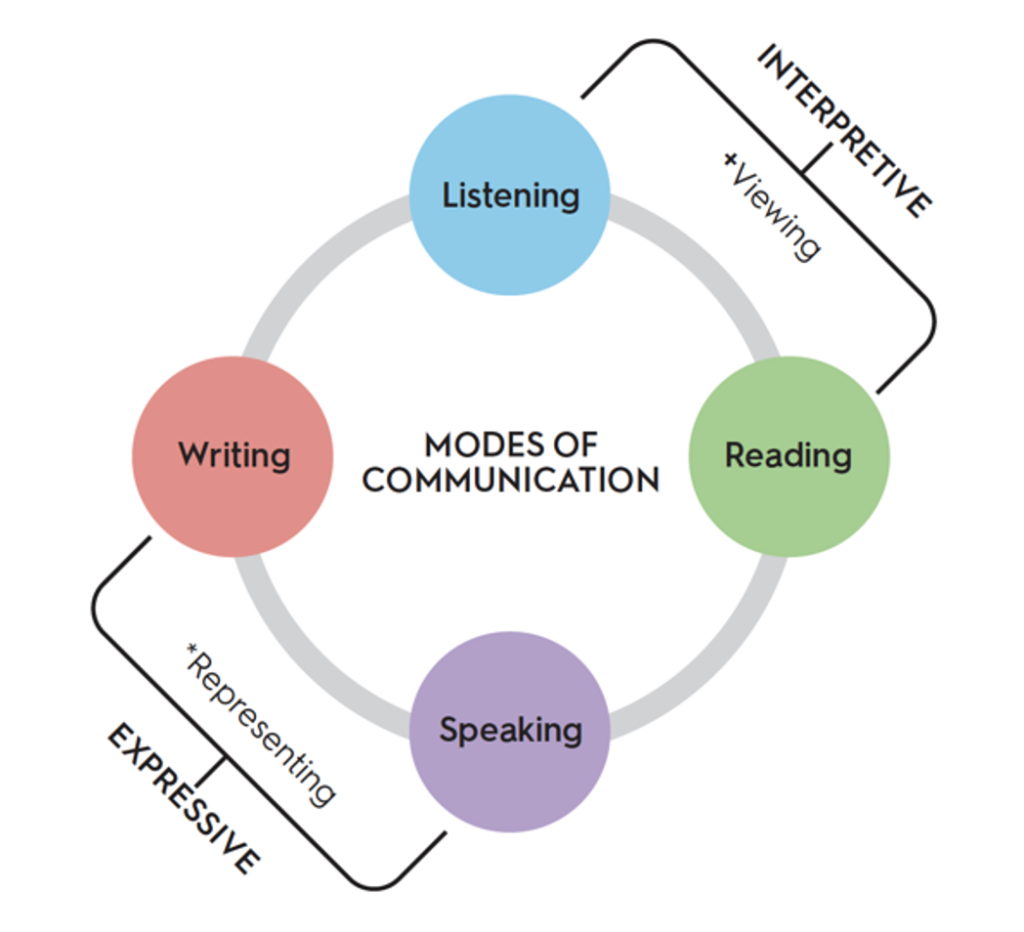
Whereas the 2012 edition used the terms Receptive and Productive communication modes, the 2020 Language Expectations and Proficiency Level Descriptors are organized by Interpretive and Expressive Modes of Communication (see Figure 6). The two updated communication modes encompass the four language domains (speaking, listening, reading, and writing), as outlined in federal requirements for language proficiency standards.
The two communication modes spotlight the multimodal nature of both language development and content area learning (Choi & Yi, 2015; Cope & Kalantzis, 2015). They also position language as being more tightly integrated with other semiotic resources (Kress & van Leeuwen, 2001).
Enhancing the four language domains (listening, reading, speaking and writing) by including viewing and representing creates a natural connection to the principles of Universal Design for Learning. The result—expanded communication modes—invites multiple means of engagement, representation, and action and expression (CAST, 2015), thereby extending accessibility principles to all multilingual learners, including those with more intensive learning needs.
Proficiency Level Descriptors: Making explicit K-12 performance definitions for individual student language development
As a reminder, the 2020 ELD Standards Framework separates Language Expectations from Proficiency Level Descriptors. This separation is important because multilingual learners do not need to first acquire “enough” English before being taught the content area curriculum. Multilingual learners in the early phases of English language development can still interpret and express grade-level concepts and skills, especially when appropriately supported through scaffolding that is inclusive of multilingual and multimodal means.
Similar to the 2012 K-12 Performance Definitions, the 2020 Grade-Level Cluster Proficiency Level Descriptors use three dimensions to conceptualize the linguistic system within a sociocultural context (illustrated in Figure 7). Consistent with the Big Idea of a Functional Approach to Language, language users are seen as simultaneously making choices in all three dimensions of language which contributes to how a text is purposely constructed and has a desired effect on its intended audience(s).
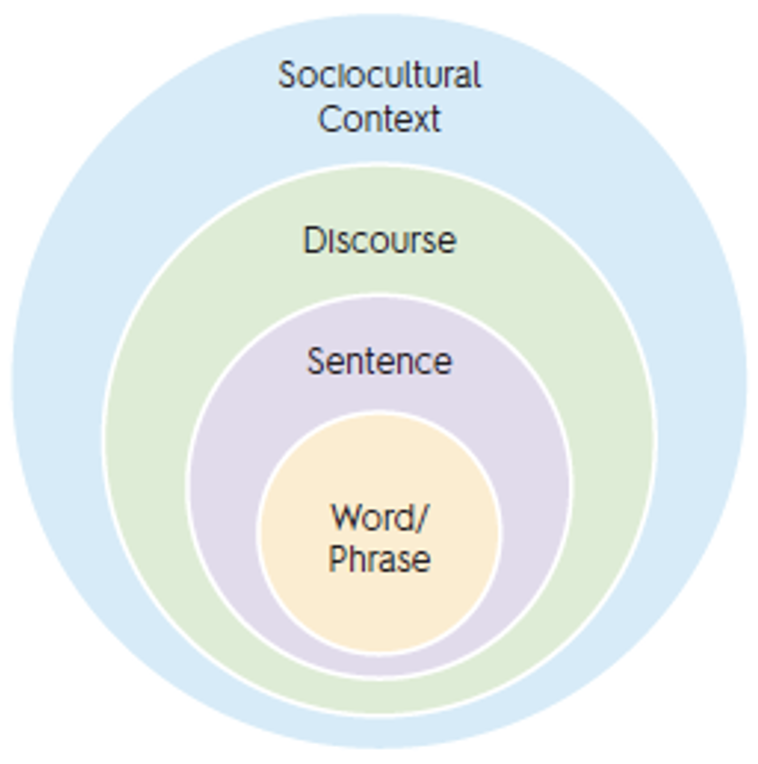
The 2020 Proficiency Level Descriptors bring an intensified focus to the discourse dimension of language use: whereas the discourse dimension has three criteria (organization, cohesion, and density of language), the sentence and word/phrase dimensions have only one criterion each: grammatical complexity of language for sentence and precision of language for word/phrase. (A companion article, Putting discourse first” [Lundgren & Shafer Willner, 2021], explores this concept in greater detail.)
Both 2012 Performance Definitions and the 2020 Proficiency Level Descriptors provide descriptions of a typical trajectory of linguistic growth for multilingual learners along continua that extend over many years. In its 2020 Edition, WIDA offers an additional proficiency level. Level 6 is open-ended as language development continues for both monolingual and multilingual students throughout life.
To avoid taking a deficit perspective about a multilingual learner’s “lack” of English, both the Performance Definitions and the Proficiency Level Descriptors were designed to help teachers identify language features that a student at each proficiency level might typically be able to use and what the student might be working toward in the next proficiency level. As a reminder: Descriptors for the end of any proficiency level include those of the previous levels. For example, Proficiency Level 4 (PL4) = End of [PL1 + PL2 + PL3 + PL4].
The 2020 Proficiency Level Descriptors are designed to be more developmentally appropriate for multilingual learners within six grade-level clusters (K, 1, 2-3, 4-5, 6-8, and 9-12). In contrast, the 2012 K-12 Performance Definitions offer a single continuum of English language proficiency descriptors. Having a single set of K-12 descriptors for the earlier standards edition meant different interpretations needed to be created for different grade-level clusters. For the most part, educators were left to create these interpretations on their own. However, one sample, yet somewhat confusing interpretation was placed in the 2016 Can Do Descriptors, Key Uses Edition:
For example, in level 5 [in the K-12 Performance Definitions], extended oral or written discourse would probably be indicated by a 1st grade student’s ability to orally retell a story in a series of sentences using simple transition words. However, a middle school student might be expected to exhibit linguistic complexity at [same] level 5 by incorporating a variety of sentence structures in an essay several paragraphs in length (WIDA, 2016, p. 3).
Using Proficiency Level Descriptors in coordination with the other 2020 ELD Standards Framework components
See Section 2 for an introduction to the Dimensions of Language Use and the five PLD criteria. See how the PLDs appear in grade-level cluster materials in Section 3. Appendix D offers a compilation of all PLDs, K-12. |
The 2020 Proficiency Level Descriptors have been carefully designed to maintain consistent criteria and equivalent levels of difficulty with those stipulated in the 2012 Performance Definitions, while also offering educators actual interpretations used with each grade-level cluster. As shown in Table 4, the 2012 and 2020 Editions use consistent criteria in the discourse, sentence, and word/phrase dimensions.
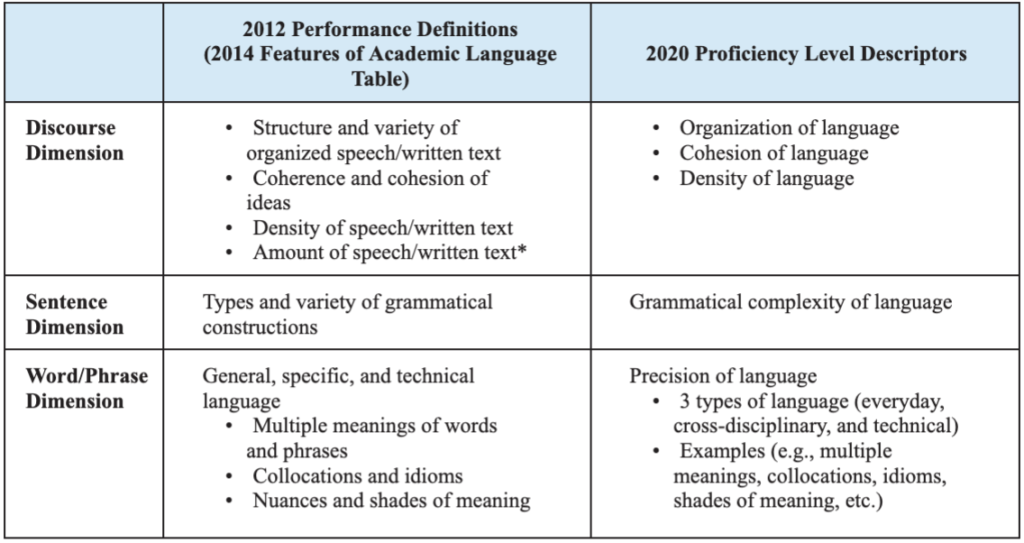
Table 4. Comparison of Criteria in 2012 Features of Academic Language Chart and 2020 Dimensions of Language Table (WIDA, 2020, Appendix D Excerpt)4
Final thoughts
Learning the ways of acting, interacting, valuing, and using tools in the disciplinary practices used by particular communities is an integral part of language learning (Gee, 2004). The 2020 ELD Standards Framework offers new opportunities for educators and policy makers to ensure access to rigorous instruction for multilingual learners. It can serve as a foundation for designing curriculum and instruction, as an advocacy tool, as well as a collaboration resource.
Educators can use standards in a variety of ways as they work with students and families. For language and content teachers, the 2020 ELD Standards Framework opens the door to address the needs of multilingual learners wherever they may be in their language development journey, helping them engage and interact meaningfully in the classroom and beyond.
Suggested next steps
Pauline Gibbons’ (2015) Scaffolding Language, Scaffolding Learning and Maria Brisk’s (2014) Engaging Student in Academic Literacies provide user-friendly introductions to the functional approach to language development. Consider exploring one or both books with your local professional development community.
Another complementary article, “The WIDA ELD Standards Framework, 2020 Edition” (Kray, Gottlieb, & Shafer Willner, 2021), appears in the Spring/Summer 2021 issue of MATSOL Currents, highlighting the main architecture and offering suggestions for deeper explorations of the 2020 Edition through selected topics in a weekly a Professional Learning Community, along with potential action steps for integrating the updated ELD Standards Framework into local curriculum, instruction, and assessment.
Notes
- The 2012 WIDA ELD Standards Framework is an amplification of (and therefore, closely connected with the design of) the 2007 WIDA ELD Standards Framework.
- As mentioned previously, resources for Standard 1 and Standards 2-5 should be integrated. For example, when designing a Science unit, collaborative teams might work from a design palette containing Standard 1 (ELD-SI) and Standard 4 (ELD-SC) Language Expectations.
- While extensive, it is important to note that the Language Features provided with the 2020 ELD Standards Framework are not exhaustive. Educators may identify other Language Features that are useful for carrying out Language Functions.
- The 2020 Proficiency Level Descriptors measure excerpts of language; neither descriptors nor examples within the Proficiency Level Descriptors describe the full amount of text that students can process or produce (e.g., chapter books).
References
Anderson, L. W., & Krathwohl, D. R. (Eds.). (2001). A taxonomy for learning, teaching, and assessing: A revision of Bloom’s Taxonomy of Educational Objectives. Allyn & Bacon.
Aguirre-Muñoz, Z., & Ambiasca, A. (2010). Defining opportunity to learn for English language learners: Linguistic and cultural dimensions of ELLs’ instructional contexts. Journal of Education for Students Placed at Risk, 15(3), 259-278. https://doi.org/10.1080/10824669.2010.495691
Brisk, M. (2014). Engaging students in academic literacies: Genre-based pedagogies for K-5 classrooms. Routledge.
Canagarajah, A. S. (1999). Interrogating the “native speaker fallacy”: Non-linguistic roots, non- pedagogical results. In G. Braine (Ed.), Non-native educators in English language teaching (pp. 77–92). L. Erlbaum Associates.
CAST. (2015). About universal design for learning. http://www.cast.org/our-work/about-udl.html#.WWO7IYTyuUk
Choi, J., & Yi, Y. (2016). Teachers’ integration of multimodality into classroom practices for English language learners. TESOL Journal, 7(2), 304-327. http://dx.doi.org/10.1002/tesj.204
Cook, V. J. (2003). Effects of the second language on the first. Multilingual Matters.
Cope, B., & Kalantzis, M. (2015). Assessment and pedagogy in the era of machine-mediated learning. In T. Dragonas, K. J. Gergen, S. McNamee, & E. Tseliou (Eds.), Education as Social Construction: Contributions to Theory, Research and Practice (pp. 350-374). Taos Institute Publications/WorldShare Books.
de Oliveira, L. C., Jones, L., & Smith, S. L. (2019). Genre-based pedagogy as an approach to second language writing. In L. Alatriste, & C. Crosby (Eds.), Second language writing across PK16 contexts: Intersections of teaching, learning, and development. University of Michigan Press.
Derewianka, B., & Jones, P. (2016). Teaching language in context (2nd ed.). Oxford.
Esteban-Guitart, M., & Moll, L. C. (2014). Funds of identity: A new concept based on the funds of knowledge approach. Culture & Psychology, 20(1), 31-48. http://dx.doi.org/10.1177/1354067X13515934
Every Student Succeeds Act of 2015, Pub. L. No. 114-95 § 114 Stat. 1177 (2015-2016).
Gándara, P. (2015). The implications of deeper learning for adolescent immigrants and English language learners. Students at the Center: Deeper Learning Research Series. Jobs for the Future.
García, O., Johnson, S. I., & Seltzer, K. (2017). The translanguaging classroom: Leveraging student bilingualism for learning. Caslon.
Gee, J. P. (2004). Situated Language and learning: A critique of traditional schooling. Routledge.
Gibbons, P. (2015). Scaffolding language, scaffolding learning: Teaching English language learners in the mainstream classroom. Heinemann.
Goldman, S., Britt, M.A., Brown, W., Cribb, G., George, M., Greenleaf, C., Lee, C., Shanahan, C., & Project READI (2016). Disciplinary literacies and learning to read for understanding: A conceptual framework for disciplinary literacy. Educational Psychologist, 51(2), 1-28. http://dx.doi.org/10.1080/00461520.2016.1168741
González, N., Moll, L., & Amanti, C. (2005). Funds of knowledge: Theorizing practices in households and classrooms. Lawrence Erlbaum.
Grant, C. A. (2012). Cultivating flourishing lives: A robust social justice vision of education. American Education Research Journal, 49(5), 910-934. http://dx.doi.org/10.3102/0002831212447977
Halliday, M. A. K., & Matthiessen, C. (2014). Halliday’s introduction to functional grammar (4th ed). Routledge.
Hyland, K. (2007). Genre pedagogy: Language, literacy and L2 writing instruction. Journal of Second Language Writing, 16(3), 148-164. http://dx.doi.org/10.1016/j.jslw.2007.07.005
Kibler, A., & Valdés, G. (2016). Conceptualizing language learners: Socioinstitutional mechanisms and their consequences. The Modern Languages Journal, 100(S1), 97-116. http://dx.doi.org/10.1111/modl.12310
Kray, F. M. (2020). Educators Bailan with Policy et le Pouvoir in the Educação of Multicultural and Multilingual Learners (WIDA ELD Standards and the Education of English Learners) [Doctoral Dissertation, University of Massachusetts, Boston]. ProQuest Dissertations & Theses Global. https://www.proquest.com/pqdtglobal/docview/2417053345/abstract/F9616A00D0504192PQ/1
Kray, F., Gottlieb, M., & Shafer-Willner, L. (2021). The WIDA ELD Standards Framework, 2020 Edition. MATSOL Currents, 44(1), 22-29. Retrievable from https://www.matsol.org/matsol-currents
Kress, G., & van Leeuwen, T. (2001). Multimodal discourse: The modes and media of contemporary communication. Arnold Publishers.
Lee, O. (2018). English language proficiency standards aligned with content standards. Educational Research, 47(5), 317-327. http://dx.doi.org/10.3102/0013189X18763775
Leont’ev, A. (1978). Activity, consciousness, and personality. Prentice-Hall, Inc.
Lundgren, C., & Shafer Willner, L. (2021). Putting discourse first. MinneTESOL Journal, 37(1). https://minnetesoljournal.org/current-issue/peer-reviewed-article/putting-discourse-first/
Martin, J. R. (2009). Genre and language learning: A social semiotic perspective. Linguistics and Education, 20(1), 10-21. https://doi.org/10.1016/j.linged.2009.01.003
May, S. (2014). Disciplinary divides, knowledge construction, and the multilingual turn. In S. May (Ed.), The multilingual turn: Implications for SLA, TESOL and bilingual education (pp. 7-31). Routledge.
Next Generation Science Standards Lead States. (2013). Next Generation Science Standards: For states, by states. The National Academies Press.
Paris, D. (2012). Culturally sustaining pedagogy: A needed change in stance, terminology, and practice. Educational Researcher, 41(3), 93-97. http://dx.doi.org/10.3102/0013189X12441244
Pennycook, A. (2010). Language as a local practice. Routledge.
Rose, D., & Martin, J. (2012). Learning to write, reading to learn: Genre, knowledge and pedagogy in the Sydney school. Equinox Publishing Ltd.
Schleppegrell, M. (2013). The role of metalanguage in supporting academic language development. Language Learning, 63(1), 153-170. https://doi.org/10.1111/j.1467-9922.2012.00742.x
Shafer Willner, L., & Castro, M. (2017). Standards Refresh Needs Assessment Report [Internal report created for WIDA]. Board of Regents of the University of Wisconsin System.
Shafer Willner, L., Percy Calaff, K., Gottlieb, M., & Kray, F. (2021). Transitioning from the ELPA21 English Language Proficiency Standards to the WIDA English Language Development Standards Framework. WAESOL Educator, 46(1), 4–12. Retrievable from https://waesol.org/publications/we/
Swan, K., Barton, K. C., Buckles, S., Burke, F., Charkins, J., Grant, S. G., Hardwick, S., Lee, J., Levine, P., & Levinson, M. (2013). The college, career, and civic life (C3) framework for social studies state standards: Guidance for enhancing the rigor of K-12 civics, economics, geography, and history. National Council for the Social Studies.
Vygotsky, L. (1978). Mind in society: The development of higher psychological processes. Harvard University Press.
Westerlund, R., & Besser, S. (2021). Making language visible in content area classrooms using the WIDA English Language Development Standards Framework. MinneTESOL Journal, 37(1). https://minnetesoljournal.org/current-issue/article/making-language-visible-in-content-area-classrooms-using-the-wida-english-language-development-standards-framework/
WIDA (2004). English language proficiency standards, Kindergarten through grade 12. Board of Regents of the University of Wisconsin System.
WIDA. (2007). English language proficiency standards for English language learners in pre-kindergarten through Grade 12. Board of Regents of the University of Wisconsin System.
WIDA. (2012). Amplification of the English language development standards. Board of Regents of the University of Wisconsin System.
WIDA. (2016). Can do descriptors, key uses edition. Board of Regents of the University of Wisconsin System.
WIDA. (2019a). WIDA can do philosophy. Board of Regents of the University of Wisconsin System. https://wida.wisc.edu/resources/can-do-philosophy
WIDA. (2019b). Guiding principles of language development. Board of Regents of the University of Wisconsin System. https://wida.wisc.edu/resources/guiding-principles-language-development
WIDA. (2020). WIDA English language development standards framework, 2020 edition: Kindergarten-grade 12. Board of Regents of the University of Wisconsin System. https://wida.wisc.edu/teach/standards/eld
Wright, L. & Musser, S. (2014). Operationalizing Key Uses of Academic Language for Test Development [Internal report prepared for WIDA]. Board of Regents of the University of Wisconsin System.

